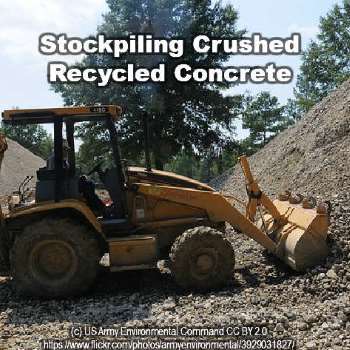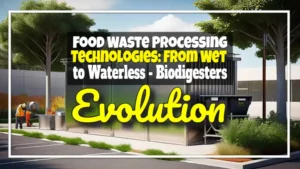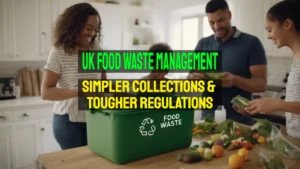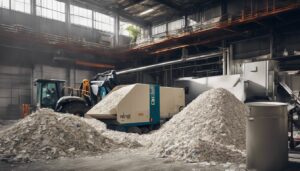Ensuring The Safe Use/Disposal of Recycled Concrete When Painted With Lead Based Paint
 On this page we provide the Wikipedia cited content from an article titled, “Recycling Revisited” which was showing as a broken link in Wickipedia (En), and an update on current guidelines.
On this page we provide the Wikipedia cited content from an article titled, “Recycling Revisited” which was showing as a broken link in Wickipedia (En), and an update on current guidelines.Original – Cited Text
“The Army Corps of Engineers' Construction Engineering Research Laboratory (CERL) has been conducting studies to see if lead-based paint in crushed concrete actually poses a hazard.ᅠ
The corps is intensely interested in concrete recycling as hundreds of aging buildings on military bases are scheduled for demolition.ᅠCERL tested buildings and materials from 300 precast family housing units at Fort Ord, Calif. Prior to demolition, CERL conducted air-ambient, air-personnel, soil, dust, building structure, and pavement tests.ᅠDuring demolition, concrete was separated from other materials and crushed with an Eagle two-stage impact crusher. Researchers took samples from the aggregate pile and from under the conveyors.ᅠBuildings, foundations and streets were crushed together to base course for use in projects at Fort Ord and the surrounding area. CERL took samples from the finished recycled aggregate product.ᅠAccording to CERL, samples from the intact buildings contained an average of 3,700 mg/kg (milligrams to kilograms) lead concentration in the paint.ᅠThis number is typical for LBP-coated concrete and is lower than what is normally found for LBP on wood surfaces.ᅠMeanwhile, the crushed aggregate from the processed piles at the crusher site had lead concentrations averaging 17 mg/kg.ᅠThe U.S. EPA limit for lead in soil in residential areas is 400 mg/kg (total lead concentration). CERL tested the two highest concentration samples for leachate potential, and the result was less than 0.01 mg/kg — far below the Resource Conservation and Recovery Act limit of five.ᅠEven in the vicinity of the crusher, CERL found that lead concentration in fines was relatively low at 111 mg/kg.ᅠWhile this concentration is well within established limits for soil, workers should still wear respiratory protection to avoid inhaling these fines.ᅠHigher concentration in concrete from driveways could be attributed to leaded gasoline exposure over the years.ᅠBut the Wisconsin DNR had to do their own research to confirm the CERL findings.ᅠ“We did some samples from three properties in the Milwaukee area,” Koziar said. “We conducted lead leachate tests and found that we were getting between 4,400 and 8,400 parts per million (ppm).”ᅠThat reading was well within NR 538 guidelines for materials that can be used in-ground without an impervious cover.ᅠWhat this means is that according to Koziar, “concrete with lead-based paint would be able to be used as clean fill without impervious cover but with some type of soil cover.”
Recycling Revisited – Requirements Updated (December 2014)
The Circular Economy In Fashion: Making Clothes Sustainable
Fast fashion fills our wardrobes, but most clothes end up in landfills within a year. Introducing the concept of the circular economy in fashion. It's the best hope for making our clothes sustainable. The global clothing industry creates over 92 million tonnes of waste each year, making it one of Earth's biggest polluters. A circular […]
The Evolution of Food Waste Processing Technologies: From Wet to Waterless Biodigesters
Read on for the latest news on the development of wet and waterless biodigesters as a means of processing Food Waste. As food waste management becomes an increasingly pressing issue for environmental sustainability, the evolution of waste processing technologies has been a game-changer in how we handle organic material. For decades, the food waste processing […]
The Future of UK Food Waste Management – Simpler Collections and Tougher Regulation
The future of UK food waste management will be a big push toward higher recycling rates through simpler collection and far greater consistency across the nations, helping citizens understand how to be green and recycle more organic waste. As the UK continues to advance its environmental goals, recently announced government policies aimed at simplifying waste […]
The Ultimate Guide To Recycling Plasterboard: How To Dispose Of Plasterboard Waste Properly
Plasterboard is a popular building material used in homes and offices. It's light, strong, and easy to work with. But when it turns into waste, we can't just throw it away like old food wrappers. Rules say plasterboard must not mix with other trash because it can harm the environment. Luckily, clean plasterboard can go […]








